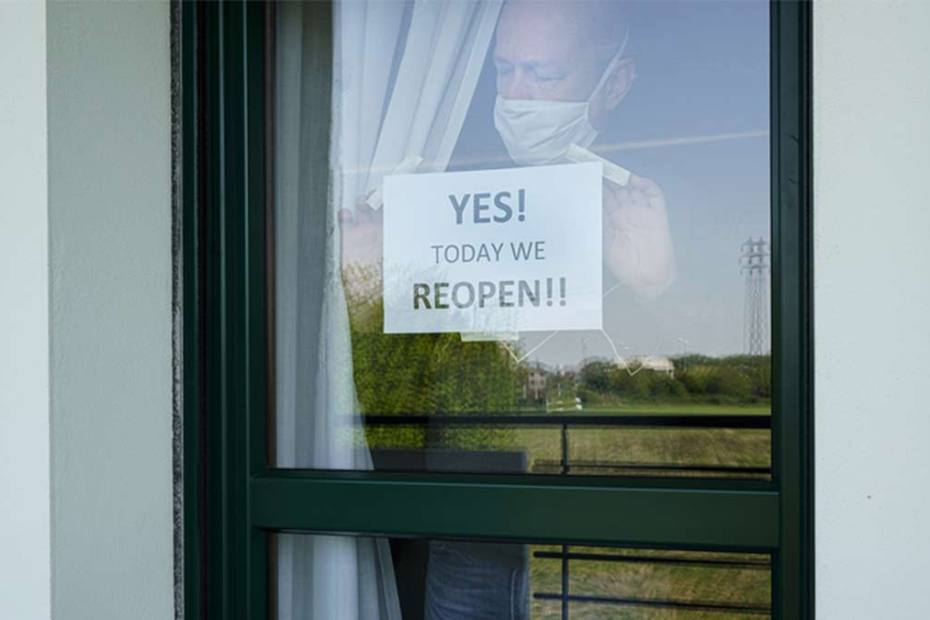Vaccine Roundup: Answers to Employers’ Most Common Vaccination Questions
With vaccinations opening to all adults in Washington within the coming weeks, employers’ most common COVID-19 questions have shifted from how to...
7 min read
 Tiffany Knudsen, SMS
:
Mar 16, 2022 9:52:07 AM
Tiffany Knudsen, SMS
:
Mar 16, 2022 9:52:07 AM

On March 12, 2022, Washington, Oregon, and California joined other states across the country by lifting mandates that required the use of masks in most indoor and some outdoor settings. Two weeks prior, the governors of these states cited declining COVID-19 cases and announced a unilateral move to ending mask mandates, leaving many employers scrambling to update their masking policies. Some employers felt pressure from employees asking when the rest of the safety protocols such as physical distancing, health screening, and increased cleaning protocols that have been in place for the last two years could be removed.
Although COVID-19 case numbers appear to be improving across the country, the Occupational Health and Safety Administration (OSHA), the Centers for Disease Control and Prevention (CDC), and many state and local health jurisdictions still have guidance in place for employers to help prevent the spread of COVID-19 in the workplace. The rate at which regulations associated with the COVID-19 virus have been updated has left some employers weary when it comes to updating their employee policies and safety protocols.
On March 12, 2022, Washington’s Labor and Industries (L&I) released updated criteria on what employers in Washington still need to do to protect workers from COVID-19 that will help answer these questions. Likewise, Oregon OSHA (OR-OSHA) released a Workplace Advisory Memo on March 14, 2022, addressing provisions to current COVID-19 rules.
Employees who work in public transportation, such as bus drivers and workers in the airline and train industries, still need to wear masks through at least April 18, 2022. The Department of Transportation (DOT) has stated that it’s working with the CDC to revise the policy framework for when and under what circumstances masks should still be worn, if at all. The updated policy is dependent on COVID-19 community levels, risks of new variants, national data, and the latest science.
Although mask mandates have been lifted for general industries at the state level, both Washington and Oregon have declared that masks will still be required in healthcare settings, long-term care facilities, and correctional facilities due to the risk levels of the populations in these environments. A goal date has not yet been announced for revising this policy.
Additionally, the CDC urges all employers and individuals to monitor local COVID-19 infection rates to determine if and when masks may be required again. The CDC has stated that individuals are less likely to contract and/or spread the virus when infection rates are low. However, all individuals should start to consider wearing a mask when community rates reach a medium-risk level, and individuals should wear masks when their community rate reaches high-risk status. The best practice for employers is to check the appropriate county risk level weekly using the CDC tracker to determine if masking policies need to be updated. Employers should communicate to employees that the organization monitors this data regularly and may require masks if the community reaches a high-risk level.
In work settings where masks are not required for employees, employers should encourage employees who are at risk for complications of the virus or who are not vaccinated to continue wearing a mask to protect themselves and those around them.
Yes. Private businesses and local governments have the right to still require masks if they choose. These employer-directed measures can range from a blanket masking policy for all individuals in the workplace or can be narrowed to only being applicable to unvaccinated individuals. In these settings, regardless of the type of policy, everyone should adhere to the requirements outlined. If your organization chooses to maintain separate masking policies, be sure to watch for potential harassment or discrimination based on vaccination status. When masks are required, employers must provide them at no cost to employees.
When possible, yes. Maintaining physical distance has been shown to reduce the spread of COVID-19. Employers should continue to physically distance workers from others, especially when the workforce is unvaccinated or when the ventilation in the workspace is poor. Physical barriers may also be used as sneeze guards or to augment physical distance.
Employers should continue to have a system to prevent sick persons from entering the workplace. Health screening is one method that employers can use for this purpose. While employers are usually limited in their ability to request and collect medical information from employees, the U.S. Equal Employment Opportunity Commission (EEOC) has stated that it is permitted during a worldwide pandemic as declared by the World Health Organization (WHO). Other methods could include updating employee work policies, signage letting individuals know that they are not permitted to enter the workspace when displaying any illness symptoms, and employee education.
Generally, no, unless the employer is covered by a federal, state, or local requirement for vaccination such as healthcare or a long-term care facility. However, businesses and organizations may still choose to implement their own vaccination verification policy.
Possibly. Healthcare employers covered under the Centers for Medicare & Medicaid Services (CMS) mandate must ensure that staff at covered facilities are vaccinated. However, employers should be aware that not all recipients of Medicare or Medicaid funds are covered by the mandate, only in healthcare settings where CMS regulates health and safety.
Federal contractors were required to comply with a federal vaccine mandate by January 4, 2022. However, there are many pending state-specific lawsuits and legal challenges to the federal mandate, and on January 21, 2022, a federal district court in Texas blocked the mandate. The directive is now on hold pending a Justice Department of appeal ruling.
In addition to federal requirements, some employers are required to enforce state vaccine mandates. In Washington, this rule applies to all Cabinet Agency worksites, employees in health care and long-term care settings and other treatment facilities, K-12 and higher education institutions, and childcare providers. In Oregon, all executive branch employees, including public safety, correctional, and healthcare settings employed by the state, and healthcare workers, teachers, educators, support staff, and volunteers in K-12 schools need to adhere to vaccination requirements.
Additionally, employers not covered by a federal or state mandate can choose to require COVID-19 vaccines for all who enter the workplace and are protected by federal anti-discrimination laws.
Yes, employers need to continue educating employees about the risks of COVID-19, reporting requirements, any relevant workplace policies, and prevention techniques, including but not limited to vaccine efficacy. Employers must provide training in a language understood by the workers and document the training topics, when the training occurred, and for whom to ensure compliance.
Possibly the most ambiguous requirement for employers is making sure their employees are protected from COVID-19 in the workplace. Both OSHA and state-run agencies such as L&I and OR-OSHA have a general duty clause that states that employers have a duty to provide a work environment free from recognized hazards that are causing or likely to cause death or serious physical harm. Over the last two years, governing agencies have posted, rescinded, updated, revised, and reversed employer COVID-19 guidance and requirements. As it currently stands, all agencies still require employers to take steps to protect workers from the virus and have stated that they will cite employers who are not protecting their workforce from the virus. These steps include:
Yes. Employers must follow their regularly applicable federal or state hospitalization and fatality reporting procedures. In addition, in Washington, if there is a COVID-19 outbreak in the workplace, employers must follow outbreak reporting requirements:
Employers should also continue to record all work-related cases of COVID-19 on their OSHA 300 Logs if the cases meet the general recording criteria. The criteria include death, days away from work, restricted work or job transfer to another job, medical treatment beyond first aid, loss of consciousness, or is a significant injury or illness diagnosed by a physician or other licensed health care provider.
Yes. Although states have different criteria for what meets work-relatedness, generally speaking, if a worker likely contracted the COVID-19 virus from the workplace, the claim will most likely be covered by workers’ compensation insurance. In addition, employers may see claims that were already allowed and closed re-open because the worker is experiencing a long-term health condition or a worsening of a condition.
Employers must continue to offer medical and religious exemption accommodations when vaccines and/or masking are required unless the accommodation creates an undue hardship for the employer. Accommodations could include but are not limited to working remote, physical distancing, the use of barrier, and COVID-19 testing.
Although not common, some employers may continue to require COVID-19 testing as a job condition. In these situations, employers must facilitate the testing for workers and cover any cost associated with the test, including time and travel.
In Washington, the Health Emergency Labor Standards Act protects high-risk workers from being discharged, permanently replaced, or discriminated against in the workplace for seeking accommodation from exposure to an infectious or contagious disease during a public health emergency.
Information is likely to continue to evolve. Employers should plan to continue to monitor federal, state, and local requirements. Employers can find updated COVID-19 resources to help stay compliant such as COVID-19 Employee Training Template PPT, Infectious Disease Plan Template, Infectious Disease Plan Checklist, and more on the COVID-19 Resources page.
Archbright will continue to update members with relevant information, and eligible members can reach out to the HR and Safety hotlines for guidance regarding questions applicable to their workplace.
For more information on Archbright membership, reach out to us at info@archbright.com.

With vaccinations opening to all adults in Washington within the coming weeks, employers’ most common COVID-19 questions have shifted from how to...

Over the past several days, Washington, Oregon, and Idaho have announced a gradual lifting of ”stay home” orders and reopening of non-essential...

Now, more than ever, Washington businesses are ‘feeling the pinch.’ Revenue margins are slimming while expectations from both internal and external...